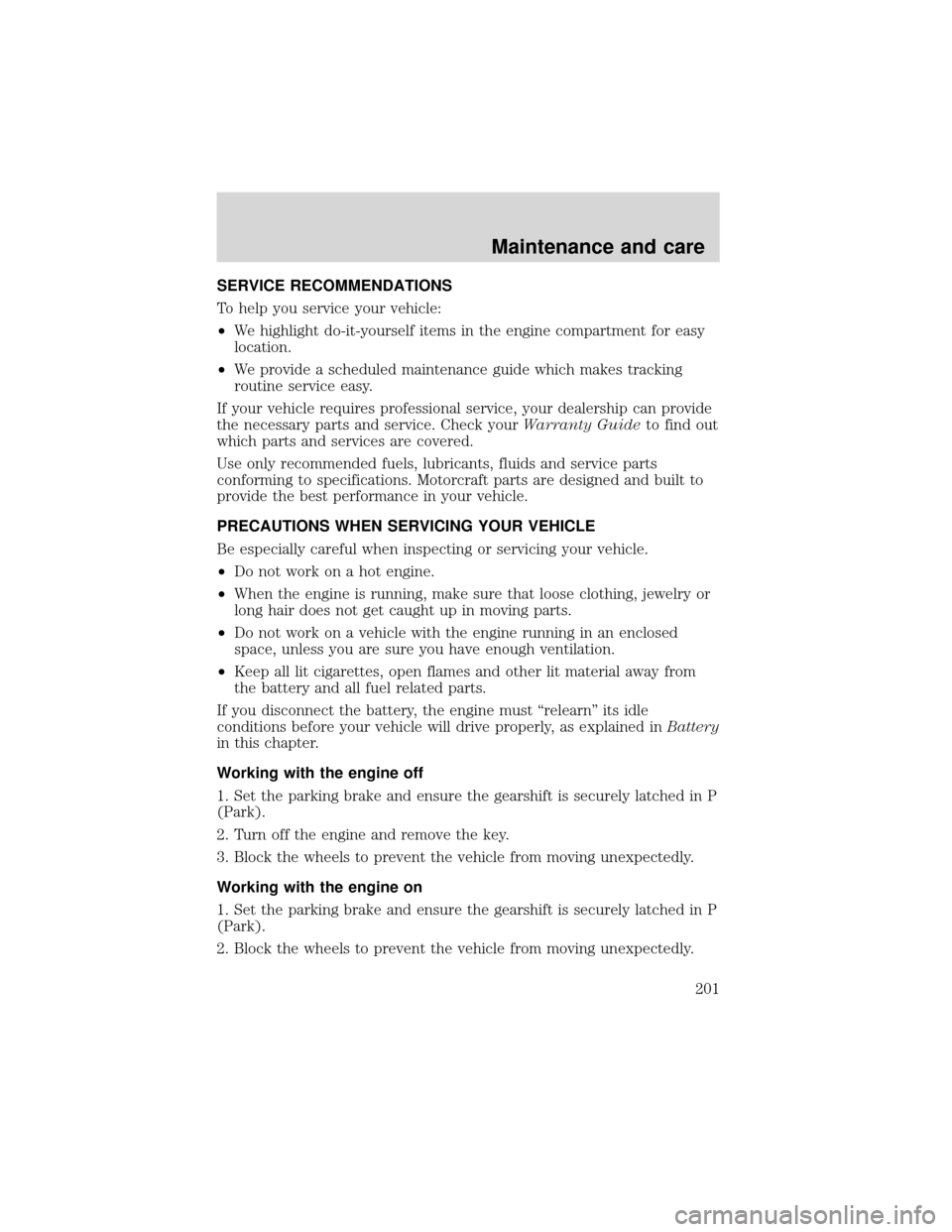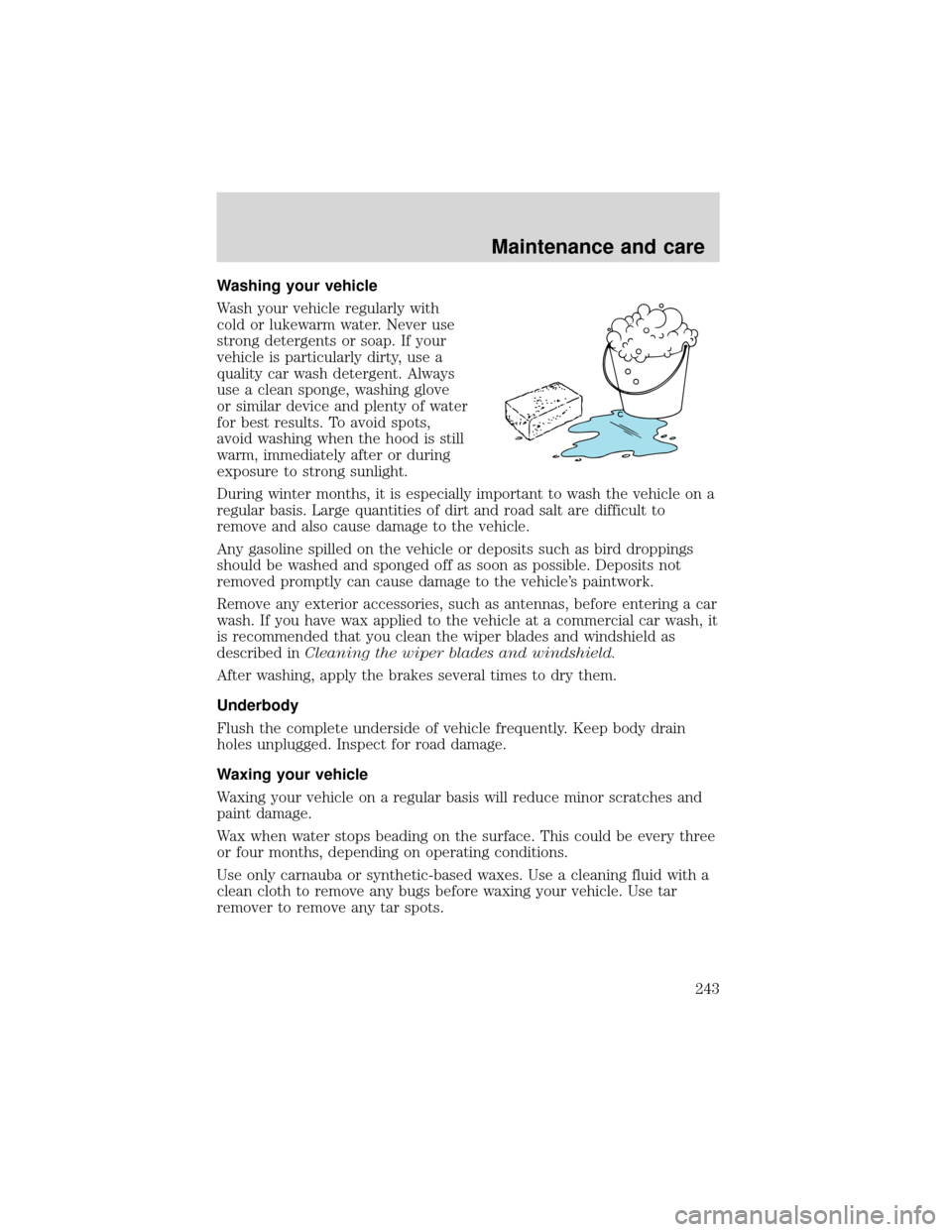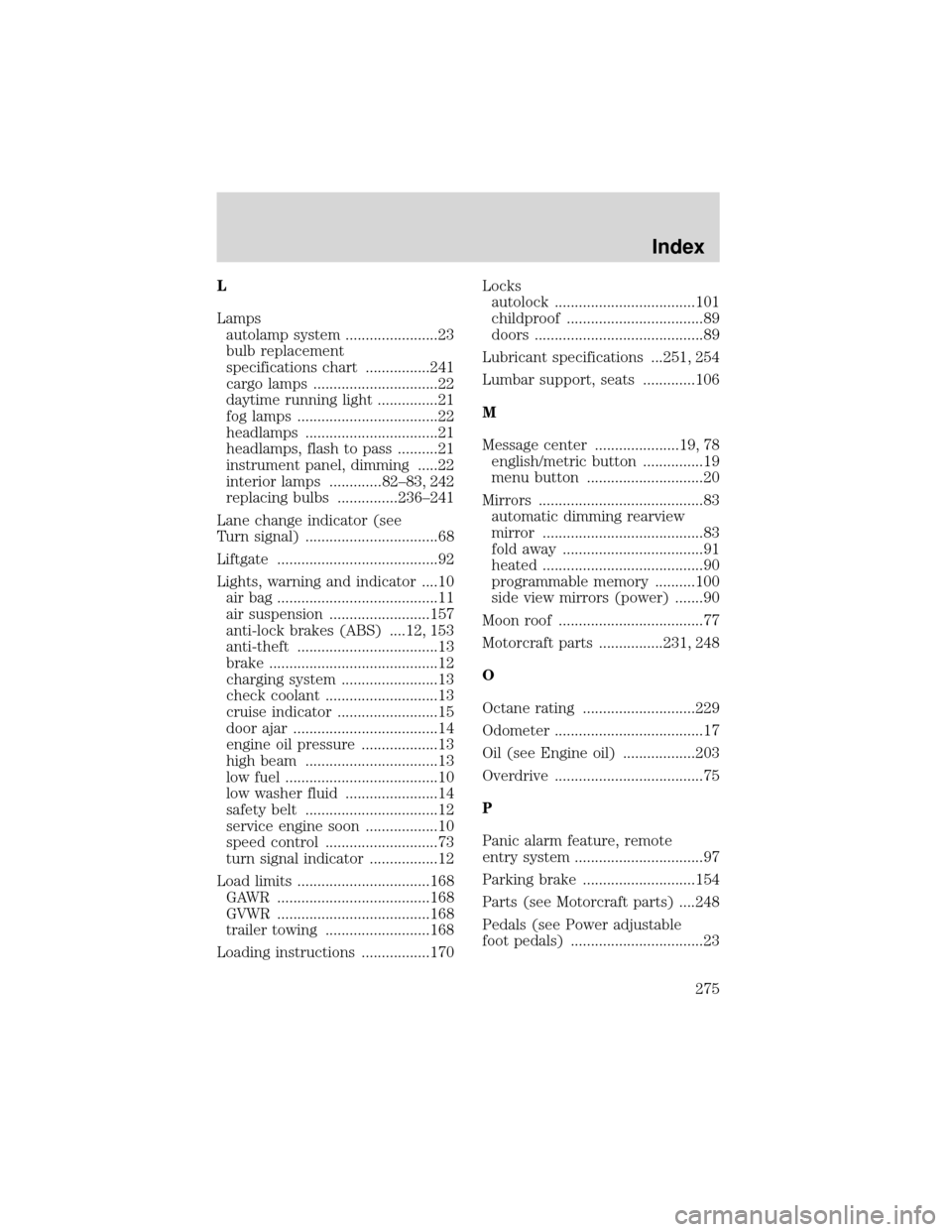2001 FORD EXPEDITION brake light
[x] Cancel search: brake lightPage 201 of 280

SERVICE RECOMMENDATIONS
To help you service your vehicle:
•We highlight do-it-yourself items in the engine compartment for easy
location.
•We provide a scheduled maintenance guide which makes tracking
routine service easy.
If your vehicle requires professional service, your dealership can provide
the necessary parts and service. Check yourWarranty Guideto find out
which parts and services are covered.
Use only recommended fuels, lubricants, fluids and service parts
conforming to specifications. Motorcraft parts are designed and built to
provide the best performance in your vehicle.
PRECAUTIONS WHEN SERVICING YOUR VEHICLE
Be especially careful when inspecting or servicing your vehicle.
•Do not work on a hot engine.
•When the engine is running, make sure that loose clothing, jewelry or
long hair does not get caught up in moving parts.
•Do not work on a vehicle with the engine running in an enclosed
space, unless you are sure you have enough ventilation.
•Keep all lit cigarettes, open flames and other lit material away from
the battery and all fuel related parts.
If you disconnect the battery, the engine must“relearn”its idle
conditions before your vehicle will drive properly, as explained inBattery
in this chapter.
Working with the engine off
1. Set the parking brake and ensure the gearshift is securely latched in P
(Park).
2. Turn off the engine and remove the key.
3. Block the wheels to prevent the vehicle from moving unexpectedly.
Working with the engine on
1. Set the parking brake and ensure the gearshift is securely latched in P
(Park).
2. Block the wheels to prevent the vehicle from moving unexpectedly.
Maintenance and care
201
Page 207 of 280

If you use a brake fluid that is not DOT 3, you will cause
permanent damage to your brakes.
Do not let the fluid level in the reservoir for the master cylinder
fall below the MIN mark. If master cylinder runs dry, this may
cause the brakes to fail.
WINDSHIELD WASHER FLUID
Washer fluid
Check the washer fluid whenever
you stop for fuel. The reservoir is
highlighted with a
symbol.
If the level is low, add enough fluid
to fill the reservoir. In very cold
weather, do not fill the reservoir all
the way.
Only use a washer fluid that meets Ford specification . Refer to
Lubricant specificationsin theCapacities and specificationschapter.
State or local regulations on volatile organic compounds may restrict the
use of methanol, a common windshield washer antifreeze additive.
Washer fluids containing non-methanol antifreeze agents should be used
only if they provide cold weather protection without damaging the
vehicle’s paint finish, wiper blades or washer system.
Do not put washer fluid in the engine coolant reservoir. Washer
fluid placed in the cooling system may harm engine and cooling
system components.
Checking and adding washer fluid for the liftgate
Washer fluid for the liftgate is supplied by the same reservoir as the
windshield.
Maintenance and care
207
Page 234 of 280

•Using the air conditioner or defroster may reduce fuel economy.
•
You may want to turn off the speed control in hilly terrain if
unnecessary shifting between third and fourth gear occurs. Unnecessary
shifting of this type could result in reduced fuel economy.
•Warming up a vehicle on cold mornings is not required and may
reduce fuel economy.
•Resting your foot on the brake pedal while driving may reduce fuel
economy.
•Combine errands and minimize stop-and-go driving.
Maintenance
•Keep tires properly inflated and use only recommended size.
•Operating a vehicle with the wheels out of alignment will reduce fuel
economy.
•Perform all regularly scheduled maintenance items. Follow the
recommended maintenance schedule and owner maintenance checks
found in your vehicle scheduled maintenance guide.
Conditions
•Heavily loading a vehicle or towing a trailer may reduce fuel economy
at any speed.
•Carrying unnecessary weight may reduce fuel economy (approximately
0.4 km/L [1 mpg] is lost for every 180 kg [400 lb] of weight carried).
•Adding certain accessories to your vehicle (for example bug
deflectors, rollbars/light bars, running boards, ski/luggage racks) may
reduce fuel economy.
•Using fuel blended with alcohol may lower fuel economy.
•Fuel economy may decrease with lower temperatures during the first
12–16 km (8–10 miles) of driving.
•Driving on flat terrain offers improved fuel economy as compared to
driving on hilly terrain.
•Transmissions give their best fuel economy when operated in the top
cruise gear and with steady pressure on the gas pedal.
•Four-wheel-drive operation (if equipped) is less fuel efficient than
two-wheel-drive operation.
•Close windows for high speed driving.
Maintenance and care
234
Page 241 of 280

Replacing license plate lamp bulbs
The license plate bulbs are located
behind the rear bumper. To change
the license plate lamp bulbs:
1. Reach behind the rear bumper to
locate the bulb.
2. Twist the bulb socket
counterclockwise and carefully pull
to remove it from the lamp
assembly.
3. Pull out the old bulb from the
socket and push in the new bulb.
4. Install the bulb socket in lamp assembly by turning it clockwise.
Using the right bulbs
Replacement bulbs are specified in the chart below. Headlamp bulbs must
be marked with an authorized“D.O.T.”for North America and an“E”for
Europe to assure lamp performance, light brightness and pattern and safe
visibility. The correct bulbs will not damage the lamp assembly or void the
lamp assembly warranty and will provide quality bulb burn time.
Function Number of bulbs Trade number
Headlamps 2 9007
Front park/turn lamps 2 3157 AK (amber)
Foglamps 2 899
Dome/map lamps 2 579
Turn/tail/brake lamps 2 3157K
Liftgate lamp 2 916
Backup lamp 2 3156K
License lamp 2 168
High-mount brake
lamp3 912
Running board lamp
(if equipped)2 168
All replacement bulbs are clear in color except where noted.
To replace all instrument panel lights - see your dealer
Maintenance and care
241
Page 243 of 280

Washing your vehicle
Wash your vehicle regularly with
cold or lukewarm water. Never use
strong detergents or soap. If your
vehicle is particularly dirty, use a
quality car wash detergent. Always
use a clean sponge, washing glove
or similar device and plenty of water
for best results. To avoid spots,
avoid washing when the hood is still
warm, immediately after or during
exposure to strong sunlight.
During winter months, it is especially important to wash the vehicle on a
regular basis. Large quantities of dirt and road salt are difficult to
remove and also cause damage to the vehicle.
Any gasoline spilled on the vehicle or deposits such as bird droppings
should be washed and sponged off as soon as possible. Deposits not
removed promptly can cause damage to the vehicle’s paintwork.
Remove any exterior accessories, such as antennas, before entering a car
wash. If you have wax applied to the vehicle at a commercial car wash, it
is recommended that you clean the wiper blades and windshield as
described inCleaning the wiper blades and windshield.
After washing, apply the brakes several times to dry them.
Underbody
Flush the complete underside of vehicle frequently. Keep body drain
holes unplugged. Inspect for road damage.
Waxing your vehicle
Waxing your vehicle on a regular basis will reduce minor scratches and
paint damage.
Wax when water stops beading on the surface. This could be every three
or four months, depending on operating conditions.
Use only carnauba or synthetic-based waxes. Use a cleaning fluid with a
clean cloth to remove any bugs before waxing your vehicle. Use tar
remover to remove any tar spots.
Maintenance and care
243
Page 271 of 280

A
Accessory delay ..........................89
Air bag supplemental restraint
system ........................128–129, 134
and child safety seats ............131
description ......................129, 134
disposal ............................133, 137
driver air bag ..................131, 135
indicator light ...........11, 133, 136
operation .........................131, 135
passenger air bag ...........131, 135
side air bag ..............................134
Air cleaner filter .......220–221, 248
Air conditioning ..........................56
automatic temperature
control system ..........................60
auxiliary heater and air
conditioner ................................66
Air suspension ...........................156
description ..............................156
warning light .............................14
Ambulance packages ....................5
Antifreeze
(see Engine coolant) ................208
Anti-lock brake system
(see Brakes) ......................152–153
Anti-theft system
warning light .............................13
Armrests ....................................106
Audio system (see Radio) .........27
Automatic transmission
driving an automatic
overdrive .................................160
fluid, adding ............................215
fluid, checking ........................215
fluid, refill capacities ..............248fluid, specification ..................254
Auxiliary power point .................26
Axle
lubricant
specifications ..................251, 254
refill capacities ........................248
traction lok ..............................157
B
Battery .......................................217
acid, treating emergencies .....217
charging system
warning light .............................13
jumping a disabled battery ....194
maintenance-free ....................217
replacement, specifications ...248
servicing ..................................217
voltage gauge ............................18
Belt minder ...............................124
Brakes ........................................152
anti-lock ...........................152–153
anti-lock brake system (ABS)
warning light .....................12, 153
brake warning light ..................12
fluid, checking and adding ....206
fluid, refill capacities ..............248
fluid, specifications .........251, 254
lubricant
specifications ..................251, 254
parking ....................................154
pedals (see Power adjustable
foot pedals) ...............................23
shift interlock ..........................159
Break-in period .............................3
C
Capacities for refilling fluids ....248
Index
271
Page 275 of 280

L
Lamps
autolamp system .......................23
bulb replacement
specifications chart ................241
cargo lamps ...............................22
daytime running light ...............21
fog lamps ...................................22
headlamps .................................21
headlamps, flash to pass ..........21
instrument panel, dimming .....22
interior lamps .............82–83, 242
replacing bulbs ...............236–241
Lane change indicator (see
Turn signal) .................................68
Liftgate ........................................92
Lights, warning and indicator ....10
air bag ........................................11
air suspension .........................157
anti-lock brakes (ABS) ....12, 153
anti-theft ...................................13
brake ..........................................12
charging system ........................13
check coolant ............................13
cruise indicator .........................15
door ajar ....................................14
engine oil pressure ...................13
high beam .................................13
low fuel ......................................10
low washer fluid .......................14
safety belt .................................12
service engine soon ..................10
speed control ............................73
turn signal indicator .................12
Load limits .................................168
GAWR ......................................168
GVWR ......................................168
trailer towing ..........................168
Loading instructions .................170Locks
autolock ...................................101
childproof ..................................89
doors ..........................................89
Lubricant specifications ...251, 254
Lumbar support, seats .............106
M
Message center .....................19, 78
english/metric button ...............19
menu button .............................20
Mirrors .........................................83
automatic dimming rearview
mirror ........................................83
fold away ...................................91
heated ........................................90
programmable memory ..........100
side view mirrors (power) .......90
Moon roof ....................................77
Motorcraft parts ................231, 248
O
Octane rating ............................229
Odometer .....................................17
Oil (see Engine oil) ..................203
Overdrive .....................................75
P
Panic alarm feature, remote
entry system ................................97
Parking brake ............................154
Parts (see Motorcraft parts) ....248
Pedals (see Power adjustable
foot pedals) .................................23
Index
275